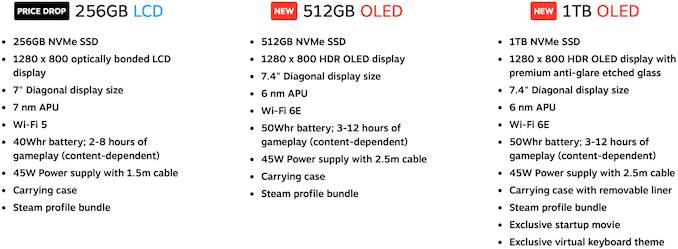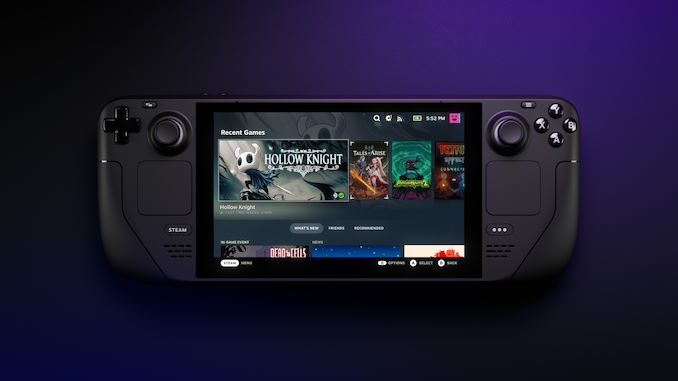Valve's Steam Deck OLED: Bigger Display, New SoC, Faster Memory, More Storage, Same Performance
by Anton Shilov on November 10, 2023 4:00 PM EST- Posted in
- Consoles
- Valve
- Steam Deck

In a quite unexpected turn of events, Valve has introduced a revamped version of its Steam Deck console that got a larger OLED display, a more efficient system-on-chip, a higher-performance memory subsystem, a 1 TB storage option, faster Wi-Fi 6E, and higher-capacity battery. While performance target of the portable gaming device remained the same, the new unit might just be faster than the original one due to faster memory. Meanwhile, the cheapest 256GB version of the console, which retained an LCD screen, now costs $399.
The main difference between the new Steam Deck OLED and the original Steam Deck is the larger 7.4-inch OLED display. The new screen retains a 1280x720 resolution, but it has a 600 nits typical brightness (a major improvement) and also supports HDR with a maximum zonal luminosity of 1000 nits, according to Tom's Hardware. The new monitor can also cover 101.8% of the DCI-P3 color gamut, up from 48.5% in case of the original Steam Deck, our colleagues found out. Despite the larger display, the console retained dimensions of the original one, but got 29 grams lighter since OLEDs do not need a backlighting module and a display driver with all the appropriate circuitry.
Another major change from the original one is that Steam Deck OLED uses AMD's new semi-custom SoC with four Zen 2 x86 cores and an RDNA 2-based GPU with 512 stream processors that is now made on TSMC's N6 process technology. Usage of N6 made the SoC a little cheaper to produce and allowed to retain the original 4W – 15W power envelope without the need to vary GPU clock from 1.0 GHz to 1.60 GHz, which may have a mild positive effect on performance in certain games.
An interesting detail about the new unit is that it uses a 16 GB LPDDR5-6400 memory subsystem with a 102.4 GB/s of peak bandwidth, up from 88 GB/s bandwidth in case of the original one. We can only wonder whether a 16% memory bandwidth boost will significantly affect gaming performance, but we feel it could bring a boost in certain bandwidth-hungry scenarios. Alternatively, faster memory may be just a bit more power efficient.
Speaking of power, it should be noted that the Steam Deck OLED also comes with a 50 Wh battery, up from a 40 Wh battery in the original one, so expect the new one to have a longer battery life. Meanwhile, the new console comes with a longer 2.5-meter power cord.
Yet another notable improvement of the Steam Deck OLED is 1 TB storage subsystem (and the M.2-2230 drive can still be replaced with something different) on the range-topping model. Meanwhile, to download games faster, Steam Deck OLED comes with a Wi-Fi 6E adapter, up from Wi-Fi 5 on the original model.
Valve launches its Steam Deck OLED in time for the holiday shopping system and in addition to make the product more attractive overall, it also makes the platform more accessible. The older 64 GB eMMC model with an LCD screen will be available for $349 while supplies last, whereas the 256 GB LCD version will cost $399 from now on (down from $529). The new Steam Deck OLED 512 GB is priced at $449, while the Steam Deck OLED 1 TB carries a $649 MSRP.
Source: Valve












49 Comments
View All Comments
Dante Verizon - Monday, November 13, 2023 - link
* old AAA titles with worse textures and bugs.iphonebestgamephone - Monday, November 13, 2023 - link
Whatever aaa that can fit in the 4-5w thermal envelope of a phone and still get 720p 30fps low settings. Make it use 20w like the deck and ypu'll get better textures and maybe even new aaa.Samus - Saturday, November 11, 2023 - link
The Snapdragon X Elite GPU is only competitive in a high-TDP scenario. The Demo B benchmarks that would mostly reflect the real-world performance in something like the Steamdeck are good but may not be good enough for a dedicated gaming device. I'm sure Valve put a lot of consideration into using the X Elite SoC with this revision and it is telling that they passed on it.iphonebestgamephone - Sunday, November 12, 2023 - link
Considering the gpu in the 8+g1 is already competitive with the deck at low tdp, hard to see the x elite not be.TheinsanegamerN - Monday, November 13, 2023 - link
Based on mobile game benchmarks.Show me a 8 gen 1 performing decently on steam games. I'll wait.
iphonebestgamephone - Monday, November 13, 2023 - link
Its based on 3dmark wildlofe extreme. But if you want you can lookup comparisons of grid autosport, alien isolation or wreckfest. Somegadgetguy on youtube did one with a deck and a gaming phone.FWhitTrampoline - Saturday, November 11, 2023 - link
Snapdragon X Elite is for Microsoft Windows based devices so maybe that was on commission for MS or there's some exclusivity agreement in place that may limit that X elite to Windows Only. The Oryon cores are not limited to just the Snapdragon Elite so the handheld gaming market is about to get interesting very soon.lmcd - Saturday, November 11, 2023 - link
There's no world where a product that still doesn't have Vulkan drivers on Windows and has poor x86-64 support on Linux will launch while AMD is providing reasonable SKUs.That is a 2-year product development gamble that literally no one can justify in this modern era of interest rates, though it might've been gambled on and funded 2 years ago.
shing3232 - Saturday, November 11, 2023 - link
it s pointless to use arm on steam deck. Might as well just use AndroidDante Verizon - Sunday, November 12, 2023 - link
They wouldn't, ARM is not more efficient than x86. It wouldn't be compatible with anything and the efficiency would be rubbish and you wouldn't pay $1500 for it.